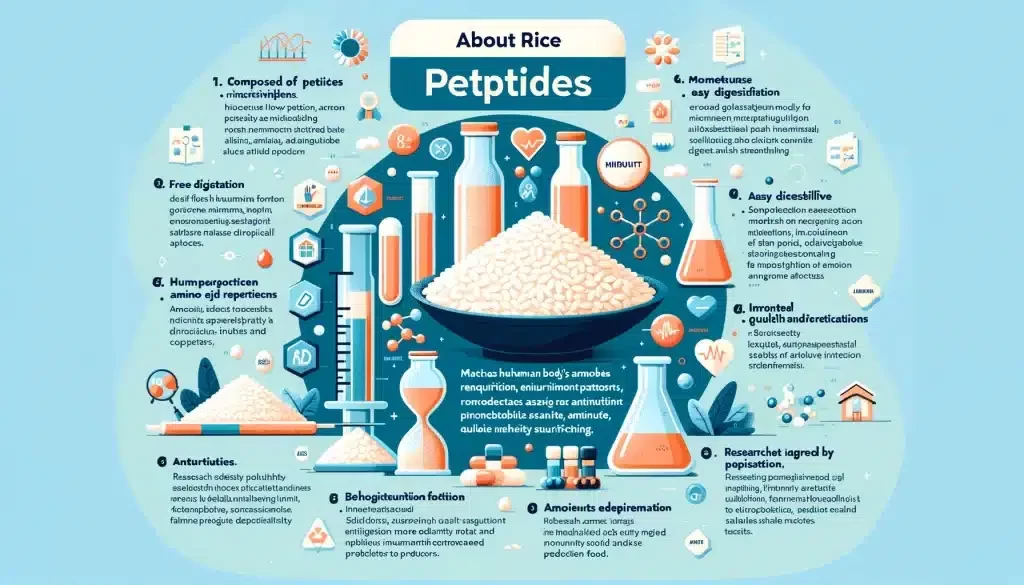Analysis of quality and comprehensive evaluation of different rice peptides based on main components
Explore the comprehensive quality evaluation of rice peptides using principal component analysis, highlighting top-ranked products and industry advancements.
Abstract
To investigate the quality of different rice peptides, this study utilized high-performance gel chromatography and amino acid analyzers among other techniques. The main components, including protein content, peptide content, molecular weight distribution, and amino acid analysis of 23 types of rice peptides, were evaluated as quality indicators. Principal component analysis (PCA) was then applied for a comprehensive quality assessment. The results revealed that 56.5% of the rice peptides had a protein content ranging between 85% and 90%. Rice peptides are a mixture of small molecular peptides, primarily consisting of components with molecular weights between 630 to 189 Da, accounting for 33.48% to 66.73% of the peptides. The amino acid composition and content varied among all rice peptides, with Glu and Asp being predominant. Comprehensive evaluation identified samples 16, 18, and 4 as the top three rice peptides. This study provides theoretical support for the quality evaluation of rice peptides, aiming to enhance the quality and promote the development and technical advancement of the rice peptide industry.
Keywords rice peptide; quality; amino acid analysis; molecular weight distribution; comprehensive evaluation
Introduction
Rice peptides are mainly composed of peptide mixtures, free amino acids, moisture, sugars, and inorganic salts, known for their low allergenic potential, easy digestibility, and biological effects. They match the human body’s amino acid requirement patterns, providing essential amino acids and peptide nutrition. Rice peptides also possess health benefits, including lipid reduction, cholesterol lowering, blood pressure reduction, antioxidant activity, and muscle strengthening, approved by health authorities for immune function food and included in health products.
With increasing research on the functionalities of rice peptides and their broadening application in food products to improve quality and flavor, the lack of national or industry standards for rice peptides has resulted in varying quality. This study aims to establish a comprehensive evaluation model for rice peptide quality using high-performance gel chromatography and amino acid analysis, thereby providing a theoretical basis for quality identification in the market and standards for rice peptide producers.
Materials and Methods
The study employed various equipment and reagents, including an automatic amino acid analyzer, nitrogen blowing instrument, high-performance liquid chromatography (HPLC) system, and others. The experiment involved measuring protein and peptide contents, determining molecular weight distribution using high-performance gel chromatography, and analyzing amino acid composition and content. Principal component analysis was then applied for a comprehensive quality assessment of the 23 different rice peptides.
Results and Discussion
The study found that the rice peptides had high protein content, with a significant portion falling within the 85% to 90% range. The peptide content mainly ranged from 70% to 80%, and the molecular weight was predominantly below 2700 Da, indicating that small molecular peptides are a major component. The amino acid analysis showed that all rice peptides contained essential amino acids, with Glu and Asp being the most abundant. The comprehensive evaluation using PCA ranked samples 16, 18, and 4 as the top quality rice peptides.
Conclusion
The research addresses the issue of inconsistent quality among rice peptide products in the market by establishing a comprehensive quality evaluation model using principal component analysis. The findings underscore the importance of controlling the quality of rice peptides during industrial production, potentially guiding the development of standards and promoting the technological advancement and market expansion of the rice peptide industry. This study offers valuable insights into quality control for rice peptide production, contributing to the growth of the industry.
For more further detailed information of this research, feel free to contact our team for asssistance.
Original research by Hu Wuyao, Huang Jing, Huang Ying, Zhao Tong, Chen Xi, Yang Xiao*
China Health Promotion Foundation Anti-Aging Nutrition and Health Research and Development Center (Wuhan 430000)














